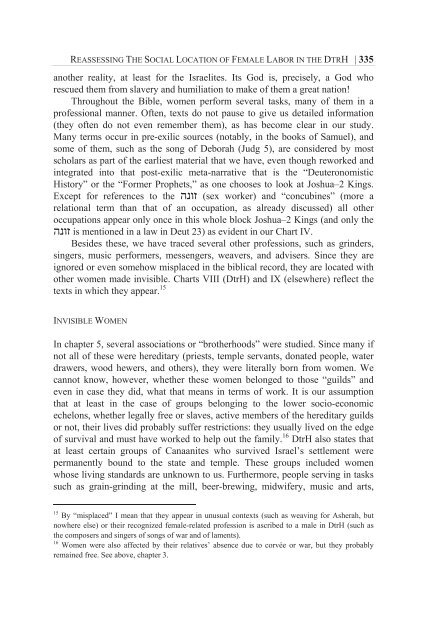Women at Work in the Deuteronomistic History - International Voices ...
Women at Work in the Deuteronomistic History - International Voices ...
Women at Work in the Deuteronomistic History - International Voices ...
Create successful ePaper yourself
Turn your PDF publications into a flip-book with our unique Google optimized e-Paper software.
REASSESSING THE SOCIAL LOCATION OF FEMALE LABOR IN THE DTRH | 335<br />
ano<strong>the</strong>r reality, <strong>at</strong> least for <strong>the</strong> Israelites. Its God is, precisely, a God who<br />
rescued <strong>the</strong>m from slavery and humili<strong>at</strong>ion to make of <strong>the</strong>m a gre<strong>at</strong> n<strong>at</strong>ion!<br />
Throughout <strong>the</strong> Bible, women perform several tasks, many of <strong>the</strong>m <strong>in</strong> a<br />
professional manner. Often, texts do not pause to give us detailed <strong>in</strong>form<strong>at</strong>ion<br />
(<strong>the</strong>y often do not even remember <strong>the</strong>m), as has become clear <strong>in</strong> our study.<br />
Many terms occur <strong>in</strong> pre-exilic sources (notably, <strong>in</strong> <strong>the</strong> books of Samuel), and<br />
some of <strong>the</strong>m, such as <strong>the</strong> song of Deborah (Judg 5), are considered by most<br />
scholars as part of <strong>the</strong> earliest m<strong>at</strong>erial th<strong>at</strong> we have, even though reworked and<br />
<strong>in</strong>tegr<strong>at</strong>ed <strong>in</strong>to th<strong>at</strong> post-exilic meta-narr<strong>at</strong>ive th<strong>at</strong> is <strong>the</strong> “<strong>Deuteronomistic</strong><br />
<strong>History</strong>” or <strong>the</strong> “Former Prophets,” as one chooses to look <strong>at</strong> Joshua–2 K<strong>in</strong>gs.<br />
Except for references to <strong>the</strong> הנוז (sex worker) and “concub<strong>in</strong>es” (more a<br />
rel<strong>at</strong>ional term than th<strong>at</strong> of an occup<strong>at</strong>ion, as already discussed) all o<strong>the</strong>r<br />
occup<strong>at</strong>ions appear only once <strong>in</strong> this whole block Joshua–2 K<strong>in</strong>gs (and only <strong>the</strong><br />
הנוז is mentioned <strong>in</strong> a law <strong>in</strong> Deut 23) as evident <strong>in</strong> our Chart IV.<br />
Besides <strong>the</strong>se, we have traced several o<strong>the</strong>r professions, such as gr<strong>in</strong>ders,<br />
s<strong>in</strong>gers, music performers, messengers, weavers, and advisers. S<strong>in</strong>ce <strong>the</strong>y are<br />
ignored or even somehow misplaced <strong>in</strong> <strong>the</strong> biblical record, <strong>the</strong>y are loc<strong>at</strong>ed with<br />
o<strong>the</strong>r women made <strong>in</strong>visible. Charts VIII (DtrH) and IX (elsewhere) reflect <strong>the</strong><br />
texts <strong>in</strong> which <strong>the</strong>y appear. 15<br />
INVISIBLE WOMEN<br />
In chapter 5, several associ<strong>at</strong>ions or “bro<strong>the</strong>rhoods” were studied. S<strong>in</strong>ce many if<br />
not all of <strong>the</strong>se were hereditary (priests, temple servants, don<strong>at</strong>ed people, w<strong>at</strong>er<br />
drawers, wood hewers, and o<strong>the</strong>rs), <strong>the</strong>y were literally born from women. We<br />
cannot know, however, whe<strong>the</strong>r <strong>the</strong>se women belonged to those “guilds” and<br />
even <strong>in</strong> case <strong>the</strong>y did, wh<strong>at</strong> th<strong>at</strong> means <strong>in</strong> terms of work. It is our assumption<br />
th<strong>at</strong> <strong>at</strong> least <strong>in</strong> <strong>the</strong> case of groups belong<strong>in</strong>g to <strong>the</strong> lower socio-economic<br />
echelons, whe<strong>the</strong>r legally free or slaves, active members of <strong>the</strong> hereditary guilds<br />
or not, <strong>the</strong>ir lives did probably suffer restrictions: <strong>the</strong>y usually lived on <strong>the</strong> edge<br />
of survival and must have worked to help out <strong>the</strong> family. 16 DtrH also st<strong>at</strong>es th<strong>at</strong><br />
<strong>at</strong> least certa<strong>in</strong> groups of Canaanites who survived Israel’s settlement were<br />
permanently bound to <strong>the</strong> st<strong>at</strong>e and temple. These groups <strong>in</strong>cluded women<br />
whose liv<strong>in</strong>g standards are unknown to us. Fur<strong>the</strong>rmore, people serv<strong>in</strong>g <strong>in</strong> tasks<br />
such as gra<strong>in</strong>-gr<strong>in</strong>d<strong>in</strong>g <strong>at</strong> <strong>the</strong> mill, beer-brew<strong>in</strong>g, midwifery, music and arts,<br />
15<br />
By “misplaced” I mean th<strong>at</strong> <strong>the</strong>y appear <strong>in</strong> unusual contexts (such as weav<strong>in</strong>g for Asherah, but<br />
nowhere else) or <strong>the</strong>ir recognized female-rel<strong>at</strong>ed profession is ascribed to a male <strong>in</strong> DtrH (such as<br />
<strong>the</strong> composers and s<strong>in</strong>gers of songs of war and of laments).<br />
16<br />
<strong>Women</strong> were also affected by <strong>the</strong>ir rel<strong>at</strong>ives’ absence due to corvée or war, but <strong>the</strong>y probably<br />
rema<strong>in</strong>ed free. See above, chapter 3.




